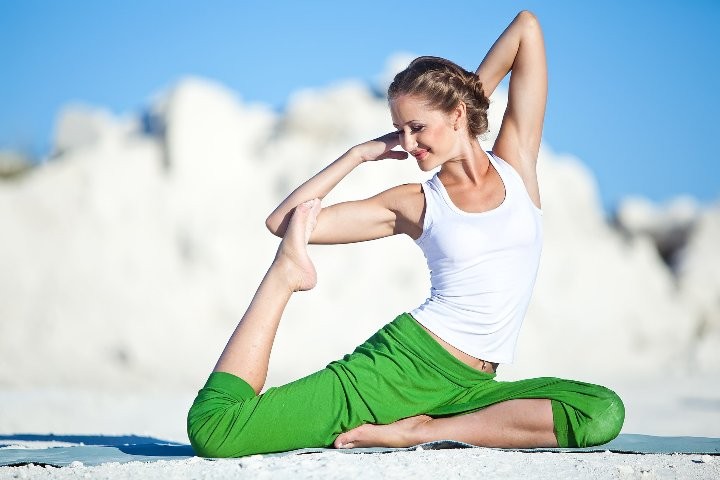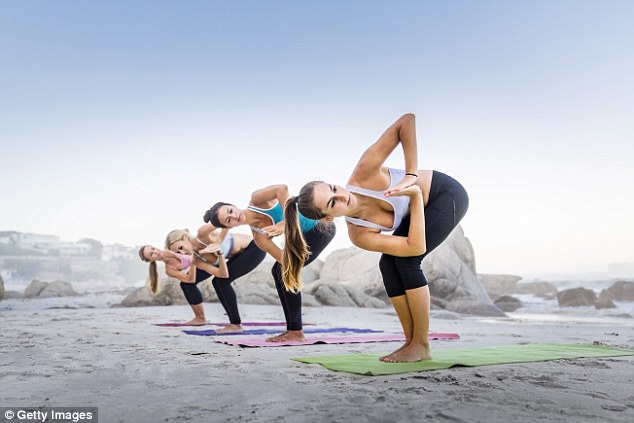A student comes to yoga because of illness, hoping that yoga can rejuvenate them, and restore health. Another comes to come yoga after hearing of the many benefits, hoping to maintain good health and prevent illness. Others may come hoping to challenge themselves physically and emotionally. And many come to relax and reduce tension and stress, drawn to the contemplative side of yoga. All will find what they are looking for in the practice of yoga.
The list of health related issues that yoga offers relief for is a very long one indeed. The ability of yoga to lower blood pressure and reduce stress assists in recovery after heart attacks. Dr. Dean Ornish, best selling author, has done considerable research into yoga and heart patients, and recommends yoga both to prevent heart attacks and as part of the recovery process. People suffering from Fibromyalgia and Multiple Sclerosis have reported a reduction in symptoms after a regular yoga practice. Yoga improves balance, muscle tone, and seems to help fight the fatigue that is part of these illnesses. Because of the focus on strengthening, gently twisting, and lengthening the spine and small muscles that surround it, yoga has a therapeutic effect on many types of backaches and pain. Some sufferers of back pain report complete freedom from pain after maintaining a regular yoga practice. Yoga can also bring relief from sports injuries, ranging from strained hamstrings, IT band pain (common in runners), and repetitive motion injuries at the joints, to tightness and loss of flexibility as muscles develop and shorten from athletic training.
Nothing can prevent aging, but yoga can certainly make growing older a more graceful and enjoyable process. Although we associate people who do yoga with pictures of the young and beautiful seen in magazines and commercials, most yogis are middle aged and older. They know first hand the numerous preventative and protective benefits of a yoga practice for physical as well as mental health. In the physical realm, yoga builds strength in the arms, legs and core (the center of the body). Strength allows us to lift things, carry groceries, yard waste, and move our own bodies with ease. The practice of yoga also maintains and improves the range of motion in the spine and joints. A flexible spine allows us to reach up to get something from the cupboard, bend down to pick something up, and turn our heads to see as we drive.
Mentally, yoga sharpens and focuses the mind. The postures are always done with focus and awareness on the breath and the body. There is not mindless repetition or chatting while practicing. Focus on the body and breath, how the two work together, the effects physically and emotionally, engage the mind and increase the ability to concentrate. A flexible, strong and active mind is just as important as a flexible, strong and active body. The breathing exercises are meant to remind us to take deep full breaths in and out, not the shallow breaths as adults we become accustomed to taking. As the inhalations and exhalations become fuller, the mind becomes calmer and more peaceful. Moreover, yoga instills a deep sense of well-being. The inward focus teaches the mind to let go of stress and negative thoughts. Areas in the body that may be misaligned or holding tension are identified and the tension can be released.
The challenges involved in practicing and studying yoga are on going. The sheer number of yoga postures, with infinite variations, keeps the body stimulated and the mind engaged. There is a complex system of philosophy and writings behind the practice detailing why the breathing and postures are done, and discussing the benefits of meditation as well. Yoga philosophy includes a system of ethics, including non-harming, non-stealing, non-hoarding, truthfulness, steadfastness, and self-inquiry. Legends and histories explain the essence of these teachings, most notably The Bhagavad Gita. If drawn to reading and studying, there are numerous other books offering opportunities to learn about and discuss yoga in this dimension as well.
The postures, breathing, and philosophy of yoga all lead to deep contemplation. The ability of yoga to relax body and mind, leading to a reduction of tension and stress is arguably, its most important benefit. Yoga allows us to become still. During a yoga class, frequent pauses are taken so that we can really notice how we are feeling; the effects the breathing and postures are having on our bodies, and what our thoughts are. A yoga class traditionally ends with students lying on their backs in relaxation pose while the teacher leads a point-by-point relaxation for the body and mind. Eventually, an interest in formal meditation practice may develop. All of the parts of yoga class are preparation for sitting in meditation.
What draws a person to start a yoga practice? There are as many reasons why as there are people taking yoga classes. When the body, breath and mind work together, positive changes both physical and mental do occur. Explore the ways yoga can benefit you, by joining a class today.




